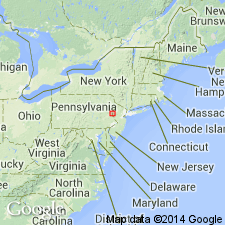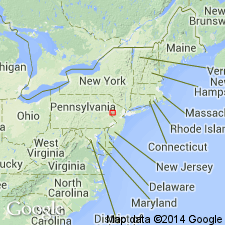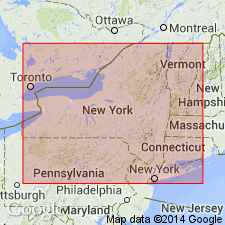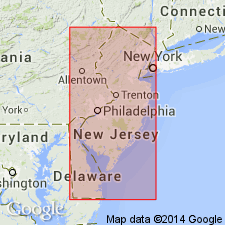
- Usage in publication:
-
- Pen Argyl beds
- Modifications:
-
- Named
- Dominant lithology:
-
- Slate
- AAPG geologic province:
-
- Appalachian basin
Summary:
Uppermost or soft slate member of Martinsburg formation, 3,000 ft thick, divided into two parts. Lower part has been quarried at Bangor and therefore is called Bangor beds. The upper part is exposed at Pen Argyl and is designated Pen Argyl beds. Slates of Bangor beds are slightly harder than those of Pen Argyl beds and do not attain such great thickness. The two slates are separated by a somewhat more sandy phase of sedimentation, which is exposed on Slateford Creek, about 1 mi west of Slateford, and which is assigned to Bangor beds.
Source: GNU records (USGS DDS-6; Reston GNULEX).

- Usage in publication:
-
- Pen Argyl Member*
- Modifications:
-
- Revised
- AAPG geologic province:
-
- Appalachian basin
Summary:
Revised the Pen Argyl to the Pen Argyl Member of the Martinsburg Formation. Consists of thick-bedded, dark-gray to grayish-black, medium-gray to yellowish-brown weathering, evenly bedded claystone slate rhythmically intercalated with thin beds of quartzose slate or subgraywacke and grayish-black to nearly black carbonaceous claystone slate. Slate beds are commonly 5 feet thick but may be as much as 15 feet thick. Thickness of member is 3,000 feet based on cross section reconstructions, but may be as much 6,000 feet. Overlies Ramseyburg Member of Martinsburg and unconformably underlies the Shawangunk Conglomerate. The Pen Argyl is of Late Ordovician age.
Source: GNU records (USGS DDS-6; Reston GNULEX).

- Usage in publication:
-
- Pen Argyl Shale
- Modifications:
-
- Revised
- AAPG geologic province:
-
- Appalachian basin
Summary:
Revised the Pen Argyl to the Pen Argyl Shale of the Martinsburg Group in NY. Overlies the Ramseyburg Sandstone of the Martinsburg. The Pen Argyl is of Late Ordovician (Mohawkian) age.
Source: GNU records (USGS DDS-6; Reston GNULEX).

- Usage in publication:
-
- Pen Argyl Member
- Modifications:
-
- Biostratigraphic dating
- AAPG geologic province:
-
- Appalachian basin
Summary:
Paleontological collections from northern NJ, eastern PA, and southern NY confirm that Martinsburg can be divided into three members according to the nomenclature of Drake and Epstein (1967): Bushkill, Ramseyburg, and Pen Argyl Members. Bushkill and Pen Argyl are not age equivalents as has been suggested by other authors. Data show that Pen Argyl and Ramseyburg Members are definitely younger than Bushkill, but are insufficient to place upper limit on Pen Argyl.
Source: GNU records (USGS DDS-6; Reston GNULEX).
For more information, please contact Nancy Stamm, Geologic Names Committee Secretary.
Asterisk (*) indicates published by U.S. Geological Survey authors.
"No current usage" (†) implies that a name has been abandoned or has fallen into disuse. Former usage and, if known, replacement name given in parentheses ( ).
Slash (/) indicates name conflicts with nomenclatural guidelines (CSN, 1933; ACSN, 1961, 1970; NACSN, 1983, 2005, 2021). May be explained within brackets ([ ]).

